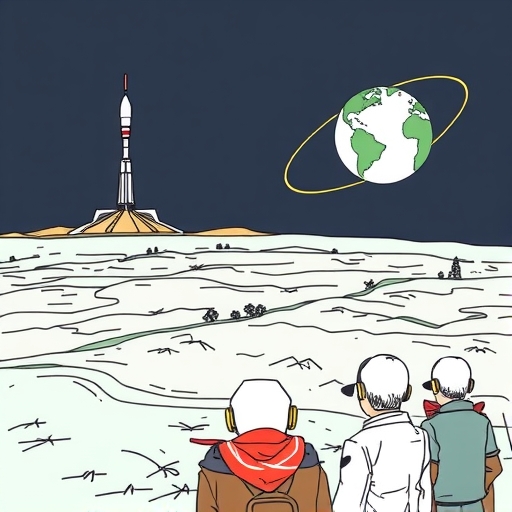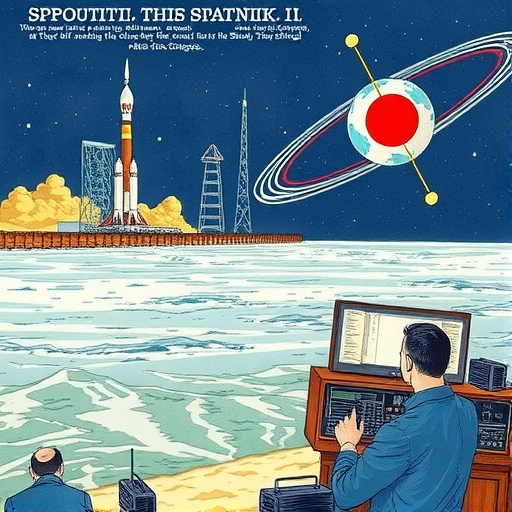The Day the Sky Changed: Understanding the Profound Impact of October 4, 1957
On October 4, 1957, a seemingly small event unfolded in the vast steppes of Kazakhstan. The Soviet Union successfully launched Sputnik I, the world’s first artificial Earth satellite, from the Baikonur Cosmodrome. For many around the globe, especially those in the United States, this wasn’t just a scientific achievement; it was a jolt, a wake-up call, and a moment that fundamentally altered the geopolitical landscape and reshaped national priorities, government spending, and the trajectory of technological investment for decades to come. As investors and individuals navigating a world driven by innovation and strategic shifts, understanding such pivotal historical moments can offer valuable perspective on how global events translate into economic and policy changes.
Key impacts of the Sputnik launch:
- Initiated the Space Race between the U.S. and the Soviet Union.
- Triggered a wave of investment in education and technology in the U.S.
- Changed public perception of national security and technological capabilities.
| Impact Area | Description |
|---|---|
| Geopolitical | Shift in international power dynamics, with the U.S. feeling pressured to respond. |
| Educational | Increased funding for STEM education to ensure future technological leadership. |
| Economic | Heightened federal investments in R&D shaped future industries. |
The Echo of the Beep: Sputnik’s Technical Details and Psychological Impact
What exactly was Sputnik I? It was surprisingly simple by today’s standards: a polished metal sphere, approximately 23 inches (58 cm) in diameter, weighing about 184 pounds (83 kg). It carried two radio transmitters operating on different frequencies, powered by batteries. Its mission was straightforward: orbit the Earth and transmit a radio signal – a distinctive “beep-beep” – that could be picked up by amateur radio operators around the world. This seemingly simple beep became one of the most powerful sounds of the 20th century.

Orbiting the Earth roughly every 98 minutes, 15 times a day, Sputnik’s signal was a constant, undeniable presence in the sky. For many, it symbolized Soviet technological prowess. For the United States, it was a source of significant alarm. The fact that the Soviets could launch a satellite meant they possessed the rocket technology powerful enough to propel an object into orbit. The unsettling implication was that they also likely possessed the capability to launch long-range missiles – specifically, intercontinental ballistic missiles (ICBMs) – that could reach American soil. This wasn’t just about science; it was about perceived military vulnerability.
The psychological impact was immense. Across the United States, citizens listened to the beeping signal on their radios, a tangible reminder that another nation had achieved a feat of technology that many Americans believed their country should have been the first to accomplish. This palpable sense of being “behind” triggered widespread anxiety and catalyzed a demand for immediate action. It was a stark realization that the competition of the Cold War wasn’t confined to political ideologies or proxy wars; it was a fierce contest of scientific and technological capability, played out on a global stage.
| Technology | Details |
|---|---|
| Diameter | 23 inches (58 cm) |
| Weight | 184 pounds (83 kg) |
| Mission | Transmit a radio signal to Earth |
A Nation Stunned: The Immediate Crisis of Confidence in the United States
The surprise and shock among experts and citizens in the United States were profound. The U.S. had its own satellite program, Project Vanguard, which was part of the nation’s contribution to the International Geophysical Year (IGY) of 1957-1958, an international collaboration for scientific study of the Earth. There was a general assumption, perhaps complacency, that the U.S. was the unquestioned leader in advanced technology, especially in rocketry, thanks in part to German scientists like Wernher von Braun brought over after World War II.
Sputnik shattered this assumption. Its successful launch demonstrated that the Soviets were not just competing; in some critical areas, they appeared to be leading. The satellite’s size was also a surprise; at 184 pounds, it was significantly heavier than the small, grapefruit-sized satellite the Vanguard project initially aimed for. This weight implied a much more powerful launch vehicle than many in the U U.S. military and scientific communities had anticipated the Soviets possessed. The immediate interpretation wasn’t just about space exploration; it was overwhelmingly framed in terms of national security and military power.
Newspapers ran banner headlines, politicians expressed alarm, and the public debated what had gone wrong. Was it a failure of American science? A lack of investment? Or something more fundamentally wrong with the nation’s approach to innovation and education? This crisis of confidence was not merely fleeting; it embedded itself deeply into the national psyche and political discourse, demanding a comprehensive response that would reshape the future of American science, technology, and defense.
The “Missile Gap” Myth and Reality: Translating Fear into Perceived Threat
The most significant fear fueled by Sputnik was not the satellite itself, but what its launch vehicle implied about Soviet ballistic missile capabilities. Rocket technology capable of putting a satellite into orbit is fundamentally the same technology required to deliver a nuclear warhead over long distances via an intercontinental ballistic missile (ICBM). Therefore, the successful launch of Sputnik was widely interpreted in the United States as proof that the Soviet Union was not only capable of launching ICBMs but potentially already possessed a significant number of them, creating a dangerous “missile gap.”
The concept of the “missile gap” became a central, highly charged issue during the late 1950s and early 1960s. Intelligence estimates varied, but the public and political narrative often exaggerated the Soviet advantage, driven by fear and political rhetoric. This perceived gap was terrifying because it suggested that the United States was vulnerable to a surprise nuclear attack without adequate means of retaliation or defense. It challenged the prevailing doctrine of Mutually Assured Destruction (MAD), which relied on both sides having a credible second-strike capability.
While later analysis would reveal that the “missile gap” was, in fact, largely a myth – the U.S. maintained a significant lead in strategic nuclear forces, particularly bombers and later ICBMs and submarine-launched missiles – the fear it generated was very real and had profound consequences. This fear provided immense political leverage for those arguing for massively increased spending on defense, rocketry, and advanced technology. It wasn’t just about closing a perceived military gap; it was about restoring national confidence and demonstrating undeniable technological superiority to both adversaries and allies.
From Shock to Strategy: President Eisenhower’s Response and Policy Shifts
President Dwight D. Eisenhower’s administration initially sought to downplay the significance of Sputnik, perhaps to avoid panic. However, the public and political pressure for a strong response quickly became overwhelming. Eisenhower, a former five-star general, understood the strategic implications but also cautioned against excessive reaction and unchecked spending. Nevertheless, the political reality demanded decisive action.

The response was multifaceted and marked a fundamental shift in U.S. policy regarding federal funding for science and technology. Eisenhower convened meetings with top scientists, engineers, and military leaders. He authorized accelerated development of U.S. satellite and missile programs. His administration quickly recognized the need for a more coordinated approach to space activities, which were scattered across various military branches and civilian agencies.
Crucially, the Sputnik shock provided the impetus to overcome bureaucratic hurdles and implement significant policy changes that had been discussed for years but lacked the necessary political will. This included not only direct investment in hardware (rockets, satellites, warheads) but also a recognition that the foundation of technological leadership lay in scientific research and education. The response wasn’t just reactive; it aimed to build a sustainable advantage.
Fueling the Future: Dramatic Increases in Federal R&D and Defense Spending
One of the most immediate and enduring consequences of the Sputnik launch was a dramatic increase in U.S. federal funding for research and development (R&D), particularly in defense and space-related fields. Before Sputnik, federal R&D spending was significant but grew incrementally. After October 4, 1957, it surged.
Congress rapidly approved substantial budget increases for the Department of Defense and other agencies involved in missile and satellite development. Programs like the Air Force’s Atlas and Titan ICBMs and the Navy’s Polaris submarine-launched ballistic missile program received massive boosts in funding and priority. The Explorer program, led by the Army under Wernher von Braun, which had previously faced funding challenges, was accelerated and ultimately resulted in the successful launch of Explorer I.
This increase in funding wasn’t limited to military applications. There was a realization that foundational scientific research across disciplines was necessary for long-term technological leadership. Federal agencies like the National Science Foundation (NSF) saw their budgets grow. Universities became crucial partners in government-funded research, establishing a model for collaboration that continues today. This period marked a significant shift in the relationship between the U.S. government, its universities, and private industry, with the government becoming the primary driver and funder of large-scale, cutting-edge research.
| Year | Funding Increase |
|---|---|
| 1957 | 30% increase in R&D funding |
| 1958 | Substantial funding approved for NASA |
| 1960 | Further increases in defense budget |
The investment strategy shifted from cautious incrementalism to urgent, mission-driven spending, prioritizing speed and breakthroughs. This created a dynamic environment for innovation, albeit one heavily tilted towards defense and aerospace initially. For those interested in markets and economic history, this serves as a powerful example of how geopolitical events can trigger massive, rapid reallocations of capital and strategic investment priorities at the national level, creating entirely new industries and technological landscapes.
Forging New Frontiers: The Creation of NASA and Other Institutions
Beyond increased funding, the Sputnik shock spurred significant institutional restructuring within the U.S. government. Prior to 1958, space-related activities were fragmented across various military branches and a civilian agency called the National Advisory Committee for Aeronautics (NACA), which focused primarily on aeronautical research.
Recognizing the need for a unified, civilian-led effort in space exploration, President Eisenhower proposed and Congress passed legislation creating the National Aeronautics and Space Administration (NASA). NASA was established on October 1, 1958, absorbing NACA and incorporating elements from various military and civilian space programs. Its mandate was clear: lead the nation’s civilian space efforts, conduct space science, and develop space technology. This was a direct response to the challenge posed by the Soviet Union’s Sputnik launch and demonstrated a commitment to competing in the space domain on a scale previously unimagined.
The creation of NASA was more than just an organizational change; it symbolized a national commitment to space exploration as a peaceful pursuit of scientific knowledge and technological advancement, distinct from military missile programs. While maintaining close ties with defense, NASA’s civilian nature allowed it to capture public imagination and garner broad support, laying the groundwork for the Apollo program and the subsequent moon landing just over a decade later. This institutional response exemplified how a strategic shock can force a nation to rethink its organizational structures to better compete in critical areas.

Other institutions and programs were also bolstered or created during this period, aimed at coordinating and accelerating scientific and technological development. This era saw the strengthening of defense R&D agencies like the Advanced Research Projects Agency (ARPA, later DARPA), which was established in early 1958 to prevent technological surprises like Sputnik from happening again. These changes underscore the profound systemic impact of the Sputnik moment.
The U.S. had its own satellite program planned, Project Vanguard, managed by the Naval Research Laboratory. However, its development was deliberate and focused on scientific goals for the IGY. When Sputnik launched, Vanguard was still under development. The highly publicized failure of the Vanguard TV3 test flight in December 1957, just two months after Sputnik, launching only a few feet before falling back and exploding, was a humiliating setback often referred to as “Kaputnik” or “Stayputnik” by the press.
This failure intensified the pressure. Fortunately, another, parallel U.S. satellite project existed within the Army Ballistic Missile Agency (ABMA) led by Wernher von Braun, utilizing the Jupiter C rocket technology developed for ballistic missile tests. This program, known as Explorer, was quickly authorized for launch by the Department of Defense after Sputnik and the Vanguard failure. On January 31, 1958, less than four months after Sputnik, the U.S. successfully launched its first satellite, Explorer I.
Explorer I was much lighter than Sputnik (about 30 pounds) but carried scientific instruments, including a Geiger counter designed by physicist James Van Allen. Its mission yielded a significant scientific discovery: the detection of radiation belts surrounding the Earth, now known as the Van Allen belts. The success of Explorer I was a crucial morale boost for the United States, demonstrating that it could indeed compete in space technology, even if slightly later than the Soviets.
The rapid authorization and successful launch of Explorer I highlights how strategic competition can accelerate programs and reallocate resources with astonishing speed when national priorities shift. It’s a lesson in the power of focused effort and overcoming bureaucracy in the face of perceived necessity, a dynamic we sometimes see replicated in markets when new technologies or competitive threats emerge.
Investing in Brainpower: The Long-Term Push for STEM Education and Workforce Development
Beyond hardware and institutions, the Sputnik shock led to a critical realization: long-term technological leadership required a highly educated workforce, particularly in science, technology, engineering, and mathematics (STEM). There was a widespread perception that the Soviet Union was producing more engineers and scientists than the United States, posing a threat to America’s future competitiveness.
In response, Congress passed the National Defense Education Act (NDEA) in 1958. While not explicitly mentioned in the source data provided, the NDEA is a direct and well-documented consequence of the Sputnik crisis. This landmark legislation provided significant federal funding to improve science, mathematics, and foreign language education from elementary school through graduate school. It funded student loans, graduate fellowships, curriculum development, and improvements in teaching methods and equipment. The name itself – “National Defense Education Act” – underscored the link between education and national security in the post-Sputnik era.
This investment in human capital had a profound and lasting impact. It encouraged more students to pursue STEM fields, expanded university research capabilities, and helped create the skilled workforce necessary for advancements not only in aerospace and defense but also in computing, electronics, and other high-tech industries that would define the late 20th century. It was a strategic investment in the nation’s intellectual infrastructure, recognizing that innovation stems from knowledge and expertise. For today’s investors, this historical example emphasizes the long-term economic value derived from investment in education and human capital, a factor often considered in analyzing national competitiveness and innovation potential.
The Sputnik Effect on Political Economy: Shaping the 1960 Election and Beyond
The fear generated by Sputnik, particularly the narrative of the “missile gap,” became a potent political issue in the United States. Democrats, including Senator John F. Kennedy, criticized the Eisenhower administration for allowing the U.S. to fall behind the Soviet Union in military technology and space. They argued for more vigorous action and increased spending to restore American leadership.
The “missile gap” was a key talking point during the 1960 presidential campaign between John F. Kennedy and Richard Nixon. Kennedy successfully used the perception of a technology and security gap to portray the Republican administration as complacent and argued that America needed to “get moving again” with new leadership and a renewed commitment to science and defense. While the actual intelligence picture was more nuanced, the political narrative of the gap resonated with an anxious public.
Kennedy’s victory is often seen, in part, as a consequence of the anxieties and demands for change that Sputnik ignited. Upon taking office, President Kennedy significantly accelerated the space program, famously setting the goal in 1961 of landing a man on the moon and returning him safely to Earth before the end of the decade. This audacious goal, a direct descendant of the Sputnik challenge, required unprecedented levels of funding and national effort, further solidifying the government’s role as a major driver of R&D and strategic investment.
The political economy of the post-Sputnik era was characterized by elevated defense spending, a sustained commitment to space exploration (even after the “missile gap” was debunked), and the intertwining of national security objectives with scientific and technological policy. This period demonstrated how a single geopolitical event could profoundly shape domestic political discourse, influence electoral outcomes, and drive long-term policy decisions regarding resource allocation and national strategy.
Ripples Across Industries: Spin-offs and Innovation Beyond Aerospace
While the initial and primary focus of the post-Sputnik investment was on defense and space, the massive influx of funding and talent into these areas had significant ripple effects across the broader economy and various industries. The technologies developed for space exploration and advanced weaponry often found unexpected civilian applications, a phenomenon known as “spin-offs.”
For example, the miniaturization of electronics, the development of advanced materials, improvements in computing (though nascent at the time), telecommunications technologies (like satellite communication), and advancements in manufacturing processes all benefited from the intensive R&D funded during the Space Race era. These developments laid foundational elements for future innovations in sectors far removed from rocketry and satellites.
The management techniques and systems engineering approaches developed for complex projects like the Apollo program also had lasting impacts on how large-scale projects are managed in both public and private sectors. The very structure of modern R&D funding, with its emphasis on peer review, project management, and milestone-based funding, was refined during this period.
This historical period illustrates a key concept for investors: significant government or strategic investment in one sector, driven by national goals or competition, can create powerful tailwinds for technological development that eventually spill over into other parts of the economy, creating new markets and investment opportunities. Understanding these historical patterns of innovation diffusion can be valuable when assessing the potential long-term impact of current major government initiatives or technological races.
A Turning Point in History: Reflecting on the Lasting Legacy of October 4, 1957
Looking back from today, the launch of Sputnik I on October 4, 1957, stands out as a truly pivotal moment in the 20th century. It was a shock that galvanized the United States into action, leading to unprecedented levels of government investment in science, technology, and defense. This event didn’t just initiate the Space Race; it accelerated the Arms Race, intensified Cold War tensions, and fundamentally reshaped American society, its educational system, and its approach to innovation.
The legacy of Sputnik is visible all around us. NASA, one of the most iconic scientific agencies in the world, is a direct result. The emphasis on STEM education, which continues today, was significantly boosted by the post-Sputnik reforms. Many technologies we use daily have roots in the R&D funded during this era of intense competition.
For us, as individuals interested in understanding the forces that shape our world and impact markets, the Sputnik story offers valuable lessons. It demonstrates how a single, unexpected event can trigger massive shifts in national strategy and investment. It shows the power of perceived threats to drive rapid technological development. It highlights the long-term returns on investment in research, education, and infrastructure. It reminds us that geopolitical competition often plays out on the battlefields of technology and economic capability.
Understanding history, like understanding market fundamentals or technical indicators, provides context. The “beep” of Sputnik was more than just a sound; it was the signal of a new era, one where the competition for technological and strategic advantage would define global power dynamics and drive innovation in ways that continue to influence our lives and the economy today. By studying such moments, we gain a deeper appreciation for the complex interplay between history, policy, technology, and the markets we navigate.
what happened on october 4, 1957?FAQ
Q:What significant event occurred on October 4, 1957?
A:The Soviet Union launched Sputnik I, the world’s first artificial Earth satellite, marking the beginning of the Space Race.
Q:How did Sputnik I impact the United States?
A:Sputnik I led to increased funding for science and technology, education reforms, and a shift in national security priorities in the U.S.
Q:What was the “missile gap”?
A:The “missile gap” referred to the perceived technological and military advantage the Soviet Union had over the U.S. regarding intercontinental ballistic missiles (ICBMs) following the launch of Sputnik.

留言